
The more cats are spoken to, the more they will speak back. You will learn a lot from your cat's wide vocabulary of chirps and meows. You will know when it is time to get up , when your cat is feeling affectionate, or when your cat is feeling threatened or is in pain.
Your cat doesn't necessarily have something urgent to tell you; a passing meow in the hallway may be a simple hello. You can also tell a great deal about what cats want or how they are feeling simply by the look in their eyes or their reaction to things.
Does your cat's back rise up to meet your hand when you pet him? This means your cat is enjoying this contact with you.
Does his back seem to collapse away under your slightest touch? Your cat is on his way somewhere and doesn't want to be held up, even by a favorite person. Please send us your experience communicating with your Cat .

Los indicadores como la mirada del gato, el tono de su voz, la posición de sus orejas y el movimiento de su cola pueden proveer importantes pistas con respecto a sus sentimientos e intenciones.
Algunas personas se sienten tontas al hablar con un gato porque piensan que al ser animales no pueden entenderlos. Sin embargo, estas mismas personas se sienten bien hablando con bebés.
Los gatos reciben efectivamente información de lo que usted les diga: reconocimiento, comfort, y una sensación de seguridad. Usted aprenderá mucho sobre el amplio vocabulario que su gato utiliza de ronroneos y miaus. Usted sabá cuándo es hora de levantarse (al menos para su gato) cuándo el gato está siendo afectuoso, o cuando el animal se siente amenazado o siente dolor.
Su gato no tiene necesariamente algo urgente que comunicarle. Un miau al pasar en el hall puede ser simplemente hola. También puede descubrir mucho de lo que el gato quiere o siente con sólo mirarlo a los ojos o analizar sus reacciones.
Su gato mueve las orejas como dos satélites cuando usted habla? Está absorbiendo todo lo que usted dice.
Su gato está en camino a hacer algo más y no quiere ser detenido, ni siquiera por su persona favorita.
Por favor envíenos su experiencia comunicándose con su gato























0 comments:
Post a Comment